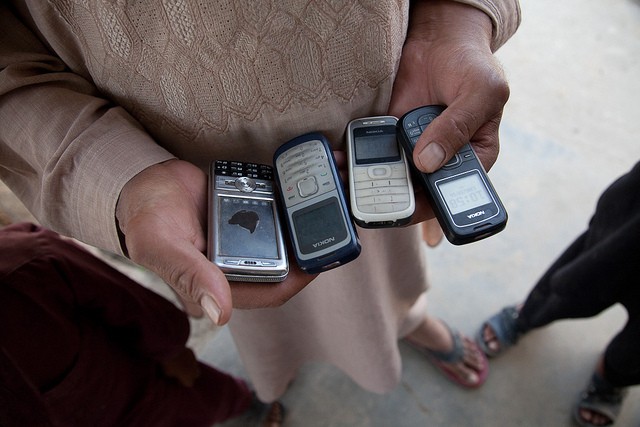By Laura Owings
Despite increasing use of mobile technologies in African healthcare, key challenges remain, writes Laura Owings.
As a community health worker tasked with tracking infant vaccinations in Kenya, Collince Oluoch was overwhelmed by the burdens of the job. He encountered mothers with no record of their children’s vaccinations, caregivers who could not remember clinic visits and colleagues who fudged figures.
“Is there not a better way to track this vital health information?” he wondered.
“Chanjoplus makes it easier to identify children who are falling through the gaps and provides real-time data on vaccination figures to improve outcomes,”
Collince Oluoch, Chanjoplus
Technological advancements such as mHealth – the use of mobile and wireless technologies including mobile phones to support healthcare are increasingly being viewed as the solution to this and many other questions about healthcare in Sub-Saharan Africa.
As the continent experiences remarkable mobile penetration and a thriving start-up market, there is hope that technology can make a big impact. Experts, however, question mHealth’s limits as projects seek traction and governments stall on regulation.
Mobile Africa
Much is said about the booming mobile market in Africa. There were over 440 million mobile subscribers on the continent in 2017, according to the Mobile economy Sub-Saharan Africa 2018 report from the GSM Association, a trade body that represents the interests of mobile network operators worldwide. By 2025, that is expected to grow to over 740 million.
On the back of those figures are soaring mHealth trends. There were 202 active mHealth services in the region in 2017, says the GSM Association report, a 58 per cent increase from 2016. And 11 per cent of the population accessed theses services on their mobile phones in 2017.
It makes senses then that projects such as the Africa Prize for Engineering Innovation are supporting mHealth initiatives. Now in its fifth year, the prize aims to support engineering-driven solutions to challenges faced on the continent such as access to water, food security, healthcare and transport and infrastructure.
Insufficient engineering capacity and skill
“Innovative engineering solutions can help to address these challenges but sufficient engineering capacity and skills to develop or implement solutions are lacking,” says Meredith Ettridge, senior manager of international development at the Royal Academy of Engineering, which sponsors the prize.
“The Africa Prize aims to stimulate and reward innovation and entrepreneurship by supporting the commercial development of engineering innovations that have a positive impact,” she adds.
In November last year, the academy announced the shortlist of 16 engineers from Sub-Saharan Africa for its 2019 prize of £25,000 (almost US$33,000). It included innovators from Burkina Faso, Kenya, Nigeria, South Africa, Uganda and Zambia. Among them was Oluoch.
These finalists will get the chance to present their businesses to judges in front of a live audience in Kampala, Uganda, in June this year after which one winner will receive the prize, and three runners up will be awarded £10, 000 (about US$13,000) each.
Chanjoplus
Fast forward from 2015 when Oluoch was a community health worker, to 2019 when he is the founder of mHealth start-up Chanjoplus, it shows his determination to use technology to resolve key challenges in healthcare.
The mobile platform works as an electronic recordkeeping system that tracks child vaccination. Children are registered onto the platform, and healthcare workers access those records to input when and where they have received vaccinations.
The tool can be accessed on a basic phone even without an internet connection.
“Chanjoplus makes it easier to identify children who are falling through the gaps and provides real-time data on vaccination figures to improve outcomes,” Oluoch says.
Vaccination rates in Kenya are on a decline. According to UNICEF, full vaccination coverage in Kenya fell from 83 per cent in 2012 to 76 per cent in 2016.
Chanjoplus may help change that by relieving the burdens of the current paper-based record system, where vaccine information is recorded in health identification booklets called health cards.
“Our product provides a solution for updating records without the need for a booklet, which, if it’s forgotten or lost, means there is no information on the child,” explains Oluoch. “When the information is updated on the mobile phone, all records are updated in real-time and accessible to the clinic, ministry of health and caregiver.”
Community buy-in
The word ‘chanjo’ means ‘to vaccinate’ in Swahili. This was a conscious decision by Oluoch, who wanted the brand’s purpose to easily resonate with Kenyans from all backgrounds.
Such attention to the community is important for establishing buy-in, says Indira Govender, a spokeswoman with the Rural Doctors Association of Southern Africa.
“Innovators must research and investigate the context and people using their technology so that they can adapt to their needs, not just come in with a system and impose it,” she says.
According to Govender, rural community health workers may be elderly and not as tech savvy as their younger counterparts. In such cases, the technology can be overwhelming and intimidating.
“Innovative engineering solutions can help to address these challenges but sufficient engineering capacity and skills to develop or implement solutions are lacking,”
Meredith Ettridge, Royal Academy of Engineering
“Something as simple as a software update can be difficult to understand,” she adds.
The result can be a push-back from the very people the innovation is trying to help. “If innovators aren’t careful, they will see people turning away from the technology,” she explains.
To overcome this challenge, Govender suggests innovators engage with the community before implementing the technology and provide support throughout the application process.
“If rural health workers can’t get support, or encounter problems without anyone available to help, the technology risks being abandoned,” she tells SciDev.Net.
mHealth policy needed
For a project to really take off, it needs to scale up and be integrated into the healthcare system, says Jill Fortuin, senior lecturer of appropriate health technologies at the University of Cape Town, South Africa.
That’s where government support should enter the equation. But rather than being a financial backer, Fortuin says governments should spearhead mHealth policy.
You might also like
- The human face of digital health
- The arduous path to make mHealth work at last
- Mobile phones worsen healthcare inequality in India
“These innovations can’t scale up unless there’s an inclusive policy around regulation and governance over who is ultimately responsible for the healthcare implication of the product,” she says.
The WHO says that “effective policy will become increasingly important as the field of mHealth matures” in its report, mHealth New horizons for health through mobile technologies.
In particular, the report cites personal security as an area in most need of policy framework. “There are legitimate concerns about the security of citizen information by programmes using mobile health technologies,” it adds.
Considering 83 per cent of WHO member states offer at least one type of mHealth service, the need for policy is increasingly urgent. Without such a policy, it is not just the innovators and their technologies that are impacted but patients as well, believes Fortuin.
“We talk about stats around how many people have mobile phones, mobile penetration and internet access but we don’t talk about the needs of the patient,” she says. “Patients need quality, accessible healthcare that is made possible with sustainable solutions.”
This piece was produced by SciDev.Net’s Sub-Saharan Africa English desk.
References
[1]The mobile economy Sub-Saharan Africa 2018 (GSM Association, 2019)
[2] Situation_analysis_of_children_and_women_in_Kenya_2017 (UNICEF, 2017)
[3] mHealth: New horizons for health through mobile technologies (WHO, 2011)
This article was originally published on SciDev.Net. Read the original article.



